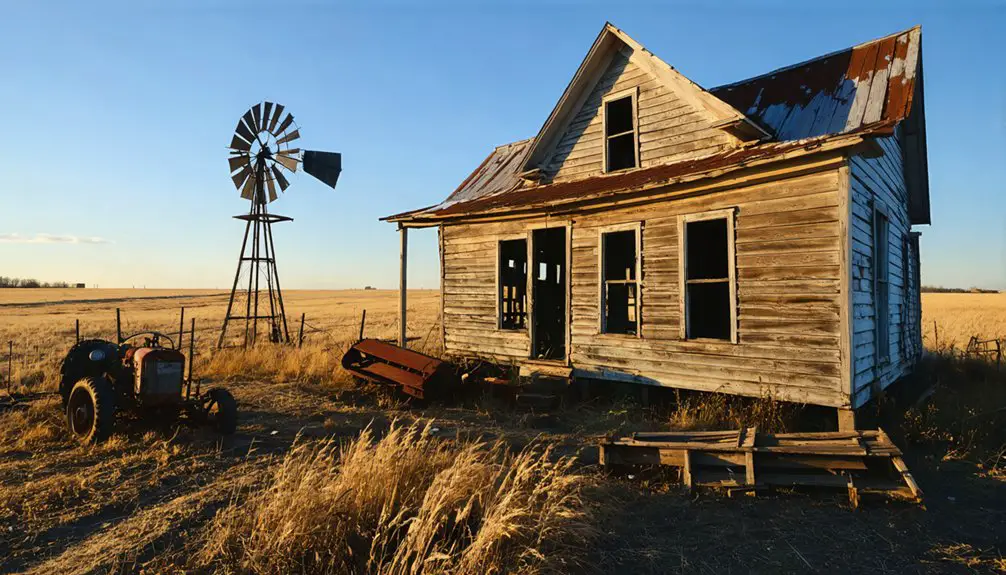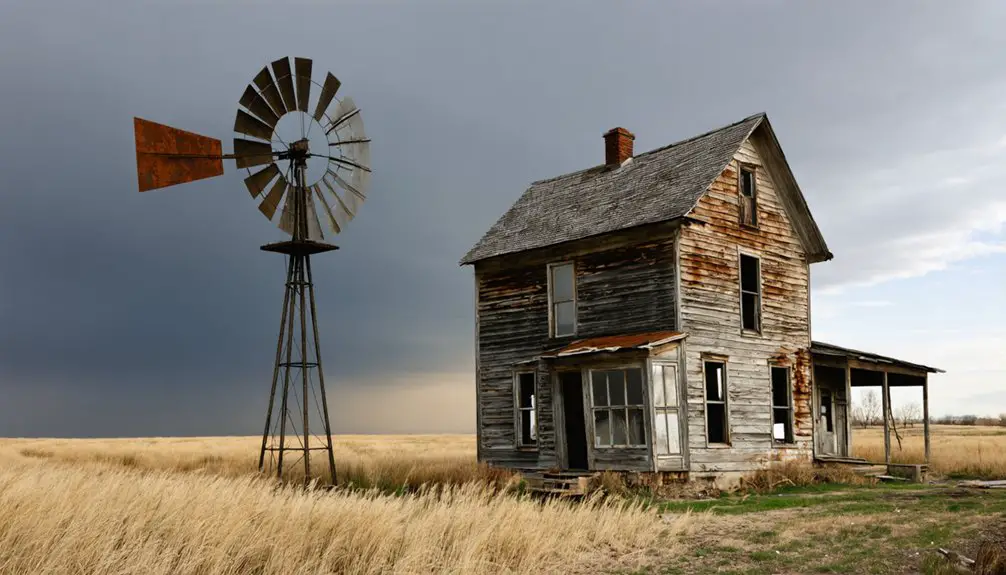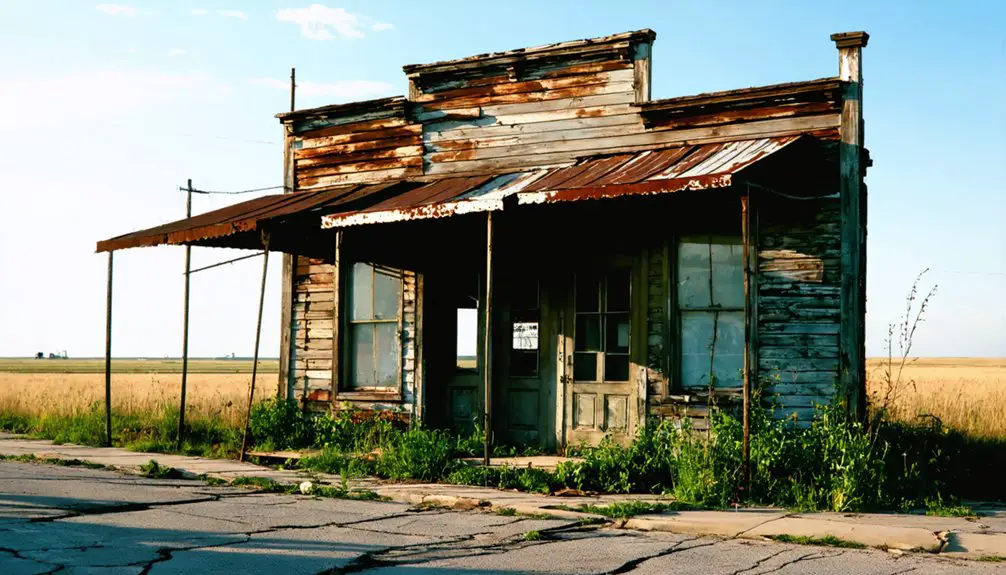You’ll find Homerville’s ghost town remnants in Gosper County, Nebraska, where it briefly flourished as the county seat from 1882-1889. The settlement began in the 1870s near Muddy Creek, with pioneers breaking tough prairie sod for $4 per acre. Despite early promise, the town’s fate was sealed when both the Union Pacific and Burlington railroads bypassed it, leading residents to relocate to Elwood. The old Homerville Cemetery holds countless stories of this once-ambitious prairie town.
Key Takeaways
- Homerville was a Nebraska pioneer settlement established in the 1870s that became a ghost town after losing its county seat status.
- The town’s decline began when the Burlington Railroad bypassed it, leading to the relocation of businesses and residents.
- After losing the county seat to Elwood in 1889, Homerville rapidly lost population and eventually became completely abandoned.
- Only the Homerville Cemetery remains as physical evidence of the former town’s existence near Wallace, Nebraska.
- The town’s demise exemplifies how railroad decisions and political changes could doom frontier settlements in late 19th-century Nebraska.
The Birth of a Prairie Settlement
When settlers first arrived in Homerville during the early 1870s, they encountered a challenging landscape at the prairie-woodland boundary that would shape their survival strategies.
Life at the edge of prairie and woodland tested early Homerville settlers, forcing them to adapt or perish.
You’d find these pioneers clustering near Muddy Creek and other waterways, where they could access limited timber for construction and secure essential water sources.
Among the most pressing settler challenges was breaking the tough prairie sod, which required oxen’s raw power rather than horses. Early settlers earned income by breaking 400 acres for neighboring homesteaders at $4.00 per acre.
You couldn’t simply plow and plant – instead, you’d have to cut holes in the sod for corn kernels and cover them by hand.
Livestock dominance emerged as the sensible adaptation, with settlers focusing on cattle, swine, and sheep rather than crops.
The vast grasslands provided wild hay for winter feed, making it possible to maintain breeding stock year-round despite the harsh conditions.
Railroad Dreams and Early Development
The promise of railroad connectivity transformed Homerville’s prospects in the early 1880s, as Nebraska’s expanding rail network offered settlers new opportunities for growth.
You’d have witnessed intense competition between the Union Pacific and Burlington railroads as they raced to establish dominance across the state’s western frontier.
The anticipation of railroad expansion drove Homerville’s early development, with settlers envisioning direct access to major market hubs like Chicago, Denver, and St. Louis.
Local entrepreneurs understood that rail connections meant economic impact far beyond simple transportation. Trains could now achieve 60 miles per hour on open routes, dramatically reducing travel times between communities.
They’d have seen how other prairie towns flourished with the arrival of daily freight and passenger service, the construction of grain elevators, and the establishment of reliable shipping routes that could carry their agricultural products to distant markets.
The Burlington & Missouri Railroad’s land grant wealth of over 2.3 million acres helped fuel rapid expansion across Nebraska’s undeveloped territories.
Rise to County Seat Status
After Gosper County gained formal recognition from the Nebraska Legislature in 1881, Homerville’s destiny changed dramatically with its victory in the 1882 county seat election.
You’ll find that Homerville’s central location played an essential role in its selection, marking a shift from the quasi-legal status of Danesville P.O.
The town’s architecture quickly evolved to match its new prominence. County officials first operated from a modest sod structure until 1884, when they constructed an impressive two-story lumber courthouse.
The town quickly developed with post office and stores, adding essential services for the growing community.
Building materials had to be hauled from neighboring Arapahoe, showcasing the determination to establish proper government facilities. The courthouse symbolized Homerville’s rise in county demographics and political importance, with plans for a county fair soon following to cement the town’s status as a regional hub.
However, the town’s prominence was short-lived when Elwood became seat in 1889.
Life in Early Homerville
Like many frontier settlements of the mid-1800s, Homerville began as a scattered collection of homesteads where hardy pioneers carved out lives from Nebraska’s untamed landscape.
You’d find simple log cabins spaced two to three miles apart, with settlers relying on hunting, small-scale farming, and livestock to survive.
Despite the isolation and settler hardships, including harsh winters and limited medical care, community resilience shone through.
You’d witness neighbors coming together for barn raisings, harvest festivals, and church services. Community members frequently participated in labor exchanges to help each other due to limited financial resources.
The mix of American and Bohemian settlers created a diverse cultural tapestry, while shared challenges forged strong bonds.
As the population grew, blacksmith shops and general stores emerged, though dirt trails and unbridged rivers made travel challenging.
Daily life centered on agricultural pursuits, with families working their land to secure ownership through homesteading acts.
The settlement faced similar challenges to those encountered by pioneers like John Prey’s family who first established homes along Salt Creek in 1856.
Political Struggles and Power Shifts
After becoming Gosper County’s seat in 1882, Homerville’s political dominance proved short-lived when the anticipated railroad bypassed the town in favor of Elwood.
Today, only the historic Homerville Cemetery remains as a testament to the former town’s existence.
The Financial Panic of 1857 had previously shown how economic forces could dramatically reshape development patterns across the American frontier.
You’ll find that voter migration followed the railroad’s path, leading to Elwood’s victory in the 1885 county seat election.
The permanent relocation of county offices to Elwood marked the end of Homerville’s brief reign as a political center, setting the stage for its eventual abandonment.
County Seat Battle
While Gosper County gained organization in 1873, its political landscape remained turbulent until the pivotal county seat battle between Homerville and Elwood in 1888.
You’ll find historical significance in how Homerville’s supporters demonstrated remarkable community resilience, organizing “Minute Men” to protect county records and using their courthouse’s second floor for strategic gatherings.
The Lincoln Land Company, backing Elwood’s bid, offered free lots to entice Homerville residents away.
Though Homerville initially won the most votes, Elwood ultimately claimed victory after legal challenges.
Despite an injunction delaying the transfer until 1889, the physical move proved challenging, especially through Devil’s Gap.
The battle’s outcome hinged largely on railroad access – while Homerville had anticipated the rail line, Elwood secured it, sealing its victory.
Voter Migration Effects
Because economic incentives shaped voter behavior, the Lincoln Land Company’s offer of free lots in Elwood triggered significant political upheaval in Homerville during the late 1880s.
You’ll find the voter demographics shifted dramatically as residents pursued economic opportunities in railroad-connected Elwood, weakening Homerville’s political influence.
Similar to how log courthouse buildings served early communities, Homerville’s political institutions struggled to maintain their authority as the town declined.
The transformation of political allegiances and power manifested in several ways:
- The “Minute Men of Homerville” formed to protect community interests as population declined.
- Rural voters typically aligned with Democrats or Populists while town precincts favored Republicans.
- Economic struggles in Homerville led to contested elections and battles over county records.
- Migration patterns created jurisdictional challenges, prompting legal fights for control over county governance.
These voter movements ultimately reshaped local political control and sealed Homerville’s fate.
The Path to Abandonment
You’ll find that Homerville’s fate was sealed when the Burlington Railroad bypassed the settlement, crushing the town’s economic aspirations and potential for growth.
The devastating blow intensified in 1888 when Homerville lost its county seat status to Elwood after a contentious election, prompting key business owners and residents to relocate.
Following these twin setbacks, Homerville’s remaining population steadily dwindled as investment ceased and development opportunities vanished, leading to its eventual abandonment.
Railroad Dreams Unfulfilled
Although Homerville initially flourished with the promise of becoming a railroad hub, its dreams were shattered when the Burlington and Missouri River Railroad bypassed the town entirely.
Early settlers’ economic optimism had driven significant investments, including a new courthouse and detailed town planning, all centered around anticipated railroad connections.
You’ll find Homerville’s decline was marked by these critical turning points:
- The railroad company chose neighboring Elwood as its preferred route, redirecting growth away from Homerville.
- Lincoln Land Company’s strategic promotion of Elwood drew businesses and settlers from Homerville.
- The contentious 1888 county seat election shifted power to rail-connected Elwood.
- Loss of the courthouse and government functions accelerated Homerville’s economic isolation.
The town’s fate was sealed when commercial activity inevitably followed the railroad’s path, leaving Homerville’s ambitious plans unfulfilled.
County Seat Loss Impact
When Homerville lost its county seat status to Elwood in 1888, the town’s decline accelerated rapidly into abandonment. The economic decline was swift and devastating as businesses shuttered and residents accepted the Lincoln Land Company’s offer of free lots in Elwood.
You’d have witnessed a mass population shift as merchants and families packed up, leaving behind their dreams of Homerville’s prominence.
The town’s social fabric unraveled quickly. The once-vibrant “Minute Men of Homerville” dances faded away as the community dispersed.
Without the promised railroad and stripped of its administrative importance, Homerville couldn’t sustain itself. What began as a promising center of county governance transformed into a ghost town, its fate sealed by the combined forces of political maneuvering and railroad development plans favoring its rival.
Legacy in Nebraska’s Historical Record
Despite its physical disappearance, Homerville maintains a lasting presence in Nebraska’s historical record as a former inland county seat of Gosper County.
Through historical narratives and oral traditions, you’ll find its memory preserved in state ghost town registries and pioneer biographies, offering insights into Nebraska’s settlement patterns.
Nebraska’s ghost towns speak through preserved stories, their silent streets echoing pioneer tales in dusty archives and biographical records.
You can trace Homerville’s enduring legacy through:
- The Homerville cemetery near Wallace, active from 1890 to 1960s, which remains a tangible connection to former residents
- Local stories, including the poignant tale of Laura (Hall) Lauhead, marked by a cedar tree and picket fence
- Family histories and EVP recordings that continue to draw visitors to the site
- Its inclusion in scholarly studies examining the rise and fall of Nebraska’s county seats
Geographic Significance and Town Layout
Located strategically within Gosper County, Homerville’s original site lies 6 miles south of Elwood and 15 miles north of Arapahoe along Highway 283.
You’ll find the former settlement about half a mile north of today’s Homerville Cemetery, surrounded by a mix of cornfields, pastures, and open terrain.
The town’s design featured a single main street running east to west, following typical mid-19th century settlement standards with 75-foot-wide streets and 16-foot alleys.
The geographic features around Homerville shaped its development, with lots measuring 50 by 150 feet adjusted to accommodate the natural landscape.
While there wasn’t an extensive grid system, the layout served both agricultural and residential needs.
The town’s position near Road 735 and local water sources supported its brief existence as a frontier community.
Homerville’s Role in Gosper County’s Evolution
The rise and fall of Homerville as Gosper County’s seat illustrates the dynamic nature of frontier settlements in late 19th century Nebraska. As the county’s population swelled from 100 to over 1,300 between 1874 and 1880, Homerville demographics reflected the influx of settlers from North Central states, along with German and Swedish immigrants.
You’ll find Homerville’s pivotal role in the county’s development marked by these key events:
- Victory in the August 1882 election securing county seat status
- Construction of the first two-story courthouse in 1884
- Shift from keeping records in officials’ homes to centralized administration
- Loss of county seat status to Elwood in 1888
Today, Homerville heritage lives on through its cemetery, established in 1890, where stories like Laura Lauhead’s unmarked grave remind us of frontier life’s challenges.
Frequently Asked Questions
What Happened to Homerville’s Original Buildings and Structures?
You won’t find any original architecture today – years of abandonment, possible fires, and lack of historical preservation efforts led to the complete disappearance of all commercial, residential and public structures.
Were There Any Significant Crimes or Notable Incidents in Homerville?
You’ll find only one major crime in the town’s history – the 1889 murder of Laura Lauhead by a family friend, followed by her husband’s interstate pursuit of the killer.
What Was the Peak Population of Homerville During Its Existence?
While you might expect precise numbers for a historic town’s peak, records suggest Homerville’s peak population during its growth likely didn’t exceed 100 residents before its eventual decline into ghost town status.
Did Any Famous or Historically Significant People Come From Homerville?
You won’t find any famous residents or people of historical significance from this place, as available records don’t document any notable individuals emerging during the town’s brief existence before decline.
What Natural Disasters or Weather Events Affected Homerville’s Development?
You won’t find any records of flood damage or drought impact specifically affecting Homerville’s development. The town’s decline was driven by economic factors, particularly when the railroad bypassed the settlement.
References
- https://history.nebraska.gov/wp-content/uploads/2017/12/doc_publications_NH1937GhostTowns.pdf
- https://nebraskarules.tripod.com/id11.html
- https://llcgs.info/cpage.php?pt=54
- https://gospercountyne.gov/webpages/history/history.html
- https://visitnebraska.com/trip-idea/explore-7-authentic-ghost-towns-nebraska
- https://history.nebraska.gov/wp-content/uploads/2017/12/doc_publications_NH1969NebPrairies.pdf
- https://usgennet.org/usa/ne/topic/resources/OLLibrary/Journals/HPR/Vol07/nhrv07p7.html
- https://www.upperbigblue.org/sites/default/files/resource-files/old-settlers-early-history-york-co.pdf
- http://govdocs.nebraska.gov/epubs/H6000/B009.0037-1991.pdf
- https://www.bnsf.com/bnsf-resources/pdf/about-bnsf/History_and_Legacy.pdf



